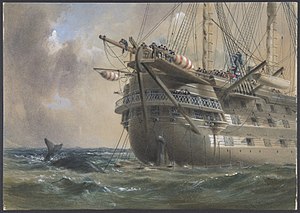HMS Agamemnon (1852)
 Agamemnon laying cable, 1858
| |
| History | |
|---|---|
| Name | HMS Agamemnon |
| Namesake | King Agamemnon of Mycenae |
| Ordered | 1849 |
| Cost | £141,299 |
| Launched | 22 May 1852 |
| Fate | Paid off 1862; sold out of service 1870 |
| General characteristics | |
| Type | Steam two-decker Agamemnon-class line-of-battle ship |
| Tonnage | 3,074 45/94 bm[2] |
| Displacement | 4,614 tons |
| Length |
|
| Beam | 55 ft 4 in (16.87 m) (extreme) |
| Draught |
|
| Depth of hold | 24 ft 6 in (7.47 m) |
| Propulsion | 600 nhp John Penn and Sons engine, 2,268 ihp (1,691 kW)[1] |
| Sail plan |
|
| Speed | 11.243 knots (20.8 km/h; 12.9 mph) under steam[1] |
| Complement | 860 |
| Armament |
|
HMS Agamemnon was a Royal Navy 91-gun battleship ordered by the Admiralty in 1849, in response to the perceived threat from France by their possession of ships of the Napoléon class.
Characteristics[]
She was the first British battleship to be designed and built from the keel up with installed steam power, although, due to the inefficiency of steam engines of the period, it was expected that she would spend much of her time travelling under sail power. She therefore carried a full square rig on three masts, in common with large sailing warships of the period.[3] She was named after Agamemnon, the King of Mycenae, who led the Greek forces in the Trojan War.
She carried an armament of muzzle loading smooth-bore cannon, typical of warships at this time, on two decks. She was completed in 1852.[3] She was not the first British battleship to be completed with steam power; HMS Sans Pareil, a pre-existing square-rigged second-rate, was converted to ancillary steam power (retaining her rig) and completed in 1851.[3]
Service[]

Agamemnon was attached to the Mediterranean Fleet and served in the Crimean War as flagship of Rear-Admiral Sir Edmund Lyons. She participated in the bombardment of Sevastopol on 17 October 1854.[citation needed] During the Great Storm of 1854, she was driven ashore on the Russian coast of the Black Sea.[4] Agamemnon participated in the shelling of Fort Kinburn, at the mouth of the Dnieper river in 1855.[citation needed]
In 1857, the government fitted out Agamemnon to carry 1,250 tons of telegraphic cable for the Atlantic Telegraph Company's first attempt to lay a transatlantic telegraph cable. Although this initial cable attempt was unsuccessful, the project was resumed the following year and Agamemnon and her U.S. counterpart, USS Niagara, successfully joined the ends of their two sections of cable in the middle of the Atlantic on 29 July 1858.[3]
Footnotes[]
- ^ Jump up to: a b Lambert, Battleships in Transition, the Creation of the Steam Battlefleet, 1815–1860 p. 124.
- ^ Winfield (2004) p.185
- ^ Jump up to: a b c d Parkes. British Battleships.
- ^ "The Gale in the Black Sea". The Times (21912). London. 30 November 1854. col A, p. 7.
Sources[]
- Lambert, A. (1984). Battleships in Transition, the Creation of the Steam Battlefleet, 1815–1860. Conway Maritime Press. ISBN 0-85177-315-X.
- Parkes, O. (1990). British Battleships. Annapolis: Naval Institute Press. ISBN 1-55750-075-4.
- Winfield, R.; Lyon, D. (2004). The Sail and Steam Navy List: All the Ships of the Royal Navy 1815–1889. London: Chatham Publishing. ISBN 978-1-86176-032-6.
External links[]
 Media related to HMS Agamemnon (ship, 1852) at Wikimedia Commons
Media related to HMS Agamemnon (ship, 1852) at Wikimedia Commons
- 1852 ships
- Battleships of the Royal Navy
- Cable ships of the United Kingdom
- Crimean War naval ships of the United Kingdom
- Maritime incidents in November 1854
- Ships built in Woolwich
- Ships of the line of the Royal Navy
- Victorian-era battleships of the United Kingdom
- Victorian-era ships of the line of the United Kingdom